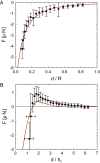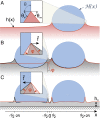Liquid drops attract or repel by the inverted Cheerios effect
- PMID: 27298348
- PMCID: PMC4941425
- DOI: 10.1073/pnas.1601411113
Liquid drops attract or repel by the inverted Cheerios effect
Abstract
Solid particles floating at a liquid interface exhibit a long-ranged attraction mediated by surface tension. In the absence of bulk elasticity, this is the dominant lateral interaction of mechanical origin. Here, we show that an analogous long-range interaction occurs between adjacent droplets on solid substrates, which crucially relies on a combination of capillarity and bulk elasticity. We experimentally observe the interaction between droplets on soft gels and provide a theoretical framework that quantitatively predicts the interaction force between the droplets. Remarkably, we find that, although on thick substrates the interaction is purely attractive and leads to drop-drop coalescence, for relatively thin substrates a short-range repulsion occurs, which prevents the two drops from coming into direct contact. This versatile interaction is the liquid-on-solid analog of the "Cheerios effect." The effect will strongly influence the condensation and coarsening of drops on soft polymer films, and has potential implications for colloidal assembly and mechanobiology.
Keywords: droplets; elastocapillarity; mechanosensing; soft matter; wetting.
Conflict of interest statement
The authors declare no conflict of interest.
Figures









Comment in
-
Role reversal: Liquid "Cheerios" on a solid sense each other.Proc Natl Acad Sci U S A. 2016 Jul 5;113(27):7294-5. doi: 10.1073/pnas.1607893113. Epub 2016 Jun 24. Proc Natl Acad Sci U S A. 2016. PMID: 27342867 Free PMC article. No abstract available.
References
-
- Tessier PM, et al. Structured metallic films for optical and spectroscopic applications via colloidal crystal templating. Adv Mater. 2001;13(6):396–400.
-
- Bowden N, Terfort A, Carbeck J, Whitesides GM. Self-assembly of mesoscale objects into ordered two-dimensional arrays. Science. 1997;276(5310):233–235. - PubMed
Publication types
Grants and funding
LinkOut - more resources
Full Text Sources
Other Literature Sources

